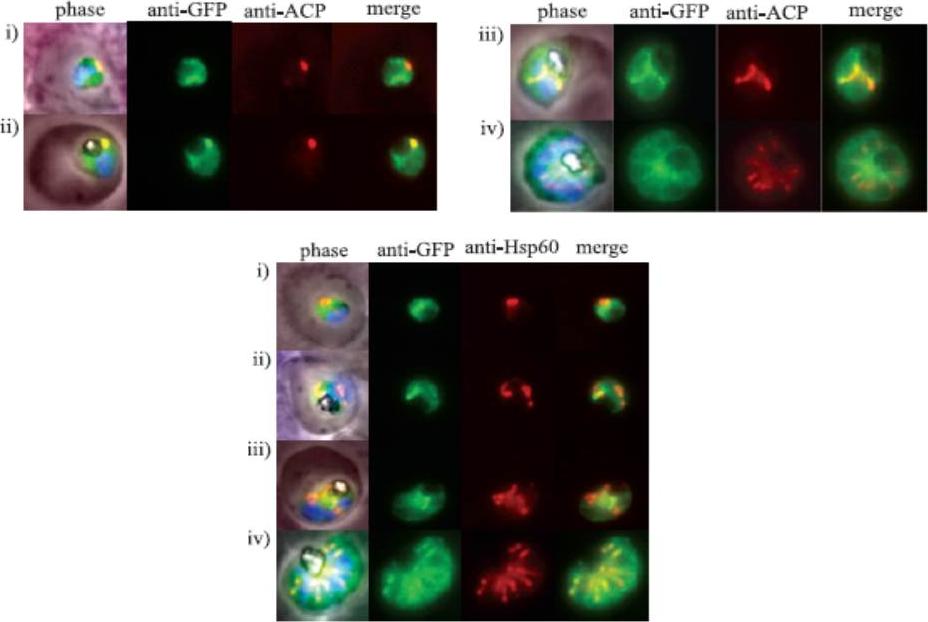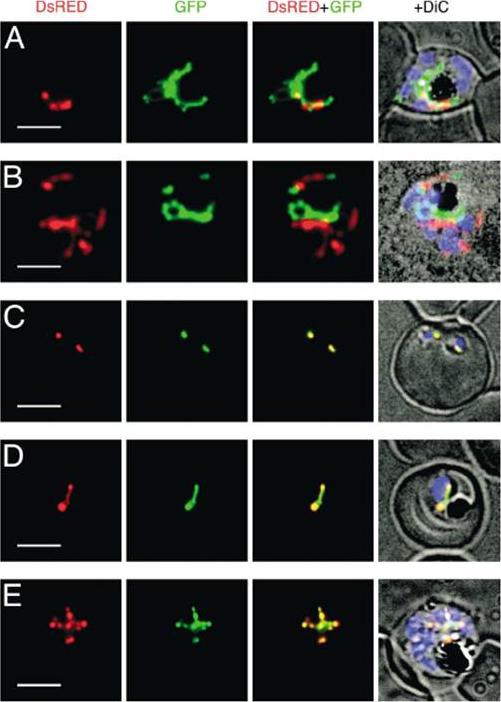PVX_100550 chaperonin CPN60, mitochondrial precursor, putative
Disruptability [+]
| Species | Disruptability | Reference | Submitter | |
|---|---|---|---|---|
| P. berghei ANKA |
Refractory |
PlasmoGEM (Barseq) | PlasmoGEM | |
| P. falciparum 3D7 |
Refractory |
USF piggyBac screen (Insert. mut.) | USF PiggyBac Screen | |
Mutant phenotypes [+]
None reported yet. Please press the '+' button above to add one.Imaging data (from Malaria Metabolic Pathways)

Upper panels: The intense fluorescent focus of FLN-GFP appears to partially overlap with that of the apicoplast. Clone MP3 parasites were fixed with 4% paraformaldehyde/0.0075% glutaraldehyde and stained with rabbit anti-ACP antibody, a marker for the apicoplast lumen (red) and goat anti-GFP antibody (green). Cells were observed by epifluorescence microscopy. (i–iv) Representative images of cells at ring, trophozoite, schizont and segmenter stages respectively. LOwer panel: FLN–mitochondrion association. Clone MP3 was examined by IFA and epifluorescence microscopy using rabbit anti-Hsp60 (red) and goat anti-GFP (green) antibodies. (i–iv) Representative images of cells at ring, trophozoite, schizont and segmenter stages respectively.Ponpuak M, Klemba M, Park M, Gluzman IY, Lamppa GK, Goldberg DE. A role for falcilysin in transit peptide degradation in the Plasmodium falciparum apicoplast. Mol Microbiol. 2007 63:314-34
See original on MMP
Expression of DsRED and GFP in Plasmodium falciparum double transfectants. Localization of fluorescent proteins DsRED (red) and GFP (green) in pSSPF2/PfHsp60-DsRED–pSSPF2/PfACP-GFP double transfectant (A), pSSPF2/PfACP-DsRED–pSSPF2/PfHsp60-GFP double transfectant (B) and pSSPF2/PfCpn60-DsRED–pSSPF2/PfACP-GFP double transfectants (C–E) was monitored by fluorescence microscopy. +DiC, overlay on a phase contrast image with the blue signal of Hoechst 33342 indicating the position of the nucleus of the parasites. (A, B) Schizont; (C) two co-infecting ring stage parasites; (D) trophozoite; (E) schizont. Scale bar: 5 mm.Sato S, Wilson RJ. The use of DsRED in single- and dual-color fluorescence labeling of mitochondrial and plastid organelles in Plasmodium falciparum. Mol Biochem Parasitol. 2004 134:175-9. Copyright Elsevier
See original on MMPMore information
| PlasmoDB | PVX_100550 |
| GeneDB | PVX_100550 |
| Malaria Metabolic Pathways | Localisation images Pathways mapped to |
| Previous ID(s) | Pv100550 |
| Orthologs | PBANKA_1446800 , PCHAS_1449000 , PF3D7_1232100 , PKNH_1451600 , PVP01_1450300 , PY17X_1449300 |
| Google Scholar | Search for all mentions of this gene |